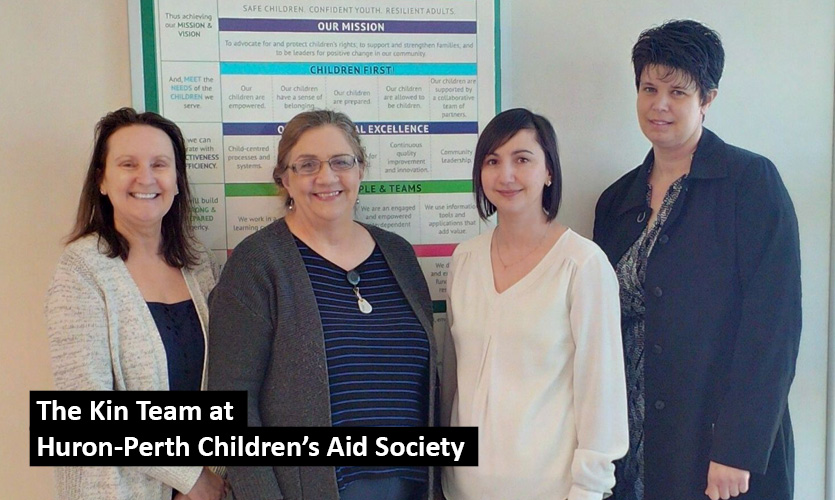Across the province Children’s Aid is reducing the number of children in care. Maxine McCaulay reveals how Huron-Perth Children’s Aid Society’s work with kin is transforming the way her agency protects children.

The Kin Team at Huron-Perth Children’s Aid Society (from left to right): Lynn, Lucille, Laurie, Lori-Ann, and Debbie (not pictured). Their persistence in locating kin has been instrumental in keeping more children out of care.
Working with kin — including relatives but also others with whom the child has a connection — when child protection concerns arise has become a growing trend among Children’s Aid Societies. Why did it become a priority for your agency?
Our philosophy is to honour the family’s ability to plan for their children and not have their child be lost to them or have the child lost to their family and identity. Whenever possible, we look for kin to take a child in while the parents address their issues; mental health and addiction problems affect many of the families we serve. Placing a child with kin is in the best interests of the child.
How do you find potential kin?
When we get involved with a family, one of our expectations is that workers ask the parents, “Can you identify three other supports who could be available to you in the event that you are not able to parent your children?” Sometimes parents aren’t willing to provide names, but we continue to dig for that information because typically there is somebody. We use a “Family Finding” process where we bring together the parents, extended family, and community. We most often see grandparents or an aunt or uncle stepping in as caregivers. But it doesn’t need to be a direct relative. One child was placed with their educational assistant as a kin option.
How do you determine whether kin will be good caregivers?
Once potential caregivers have been found, we do a kin assessment. Because the kin become the parents, they have to demonstrate that they’re able to meet the needs of the child as if they were the parent. We assess their ability to provide for the child long term. Our hope is that if the child cannot return to their biological parent, the kin will make an application for legal custody to give that child some permanency.
What kind of support do kin caregivers receive from your agency?
Kin can provide care for children in two different ways. In “kin service,” which is how children are increasingly being looked after, children do not formally come into the care of a CAS. “Kin care” is an alternate option that still involves kin, but the children are considered in the care of a CAS. In addition, caregivers in kin care must go through the same assessment process and training courses that foster families do. They receive financial assistance through the CAS to provide care for the child. Children in kin care are also assigned a children’s service worker.
With “kin service” we do our best to give children and their caregivers the same kind of support received by families with “in care” status. But an important difference is that no financial resources are provided to “kin service” families. Kin may be eligible for Temporary Care Assistance through Ontario Works or some supports from the CAS, such as food vouchers, daycare, summer camp, and covering hydro bills. As an agency, we do what we can, but unfortunately this support can’t be on a regular basis. So one of the things we look for when we do the kin service assessment is the caregiver’s ability to financially provide for this child long term.
The placement of children with kin came under scrutiny during the Jeffrey Baldwin inquest. How does your agency address the concerns around kin placement in the shadow of the inquest?
It’s really critical to do a thorough file review, which was not done with Jeffrey Baldwin’s caregivers. We make sure that we follow the Child Protection Standards and complete as thorough an assessment as possible. This includes interviews with the child and caregivers, checking identification, as well as conducting child welfare and criminal record checks. As a worker, you need to make sure, from the get-go, that you’ve done your homework and covered all the bases, that you’ve done your research, you’ve read the file. After the kin assessment is complete, the child protection worker visits with the child in the kin home monthly, and with the kin worker at a minimum of quarterly. Service managers have stressed the importance of completing a file review before placing a child with kin.
How successful has your effort been to put kin first?
We’re seeing way fewer children going into care. Children are still being admitted into care, but we work really hard to find a kin placement. Even if they come into care for a little bit, we work really hard to find those kin. We’ve seen the number of children in kin service go up every year for the past 5 years. The monthly average number of children in kin service went from 32 in 2010–2011 to 58 in 2014–2015.